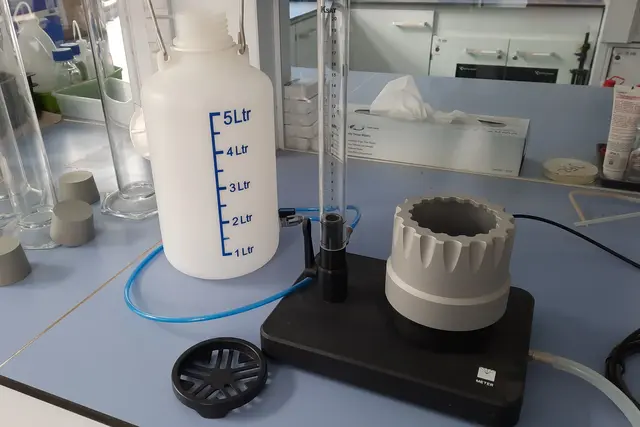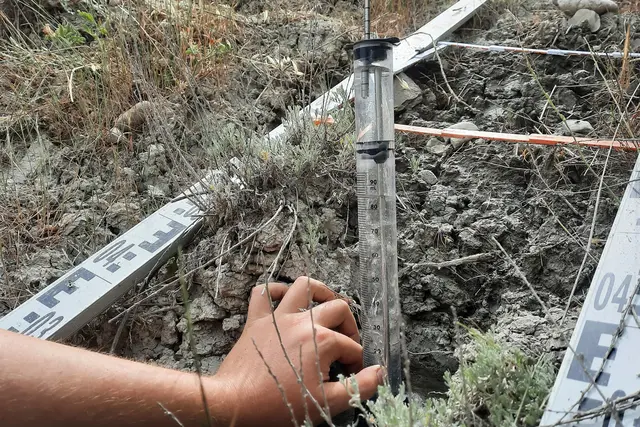
Equipment at the department
The KSAT for measuring saturated hydraulic conductivity in the laboratory

Hydraulic conductivity is a material property of soil and is determined by the pore size distribution and the connectivity of the water-filled pores. Saturated conductivity differs from unsaturated conductivity. If the soil is not saturated with water, the large pore spaces are mainly filled with air and the flow cross-section is smaller, i.e., the soil's ability to allow water to pass through is lower. However, it is difficult to completely saturate the soil in the field. This is why KSAT is used in the laboratory.
Mini Disk Infiltrometer

Thanks to its compact design and because it is easy to use, the infiltrometer can be used to take measurements almost anywhere. If you want to determine the unsaturated hydraulic conductivity and infiltration rates of soil and do not want to carry around a lot of extra weight, the mini disk infiltrometer is the device of your choice. Once the burette has been filled with water and the suction rate has been set, the infiltration can be measured. The unsaturated hydraulic conductivity of the soil can be calculated based on the time elapsed.
Double-ring Infiltrometer
![[Translate to English:] Doppelring-Infiltrometer Double-ring Infiltrometer](/fileadmin/_processed_/4/9/csm_20220531_163602_092ebca8b4.webp)
The double-ring infiltrometer is a simple instrument for determining water infiltration. The two rings can be used to determine the infiltration of soils. The outer ring prevents lateral seepage, allowing the water infiltrated in the center to be measured accurately. This makes it possible to determine the infiltration capacity and infiltration rate of the soil from the volume of water per soil surface in a defined time unit.
The ring infiltrometer can be used for a wide variety of purposes and is suitable for almost all kinds of soils.
Guelph Permeameter
![[Translate to English:] Guelph-Permeameter Guelph permeameter](/fileadmin/_processed_/6/f/csm_IMG_0085_539c371f44.webp)
The Guelph permeameter measures the water permeability (hydraulic conductivity) of the soil at a depth of up to 75 cm in a previously cylindrically dug borehole. This borehole infiltrometer or permeameter determines the water permeability of the soil from a constant delivery head according to the “Mariotte bottle” principle. It is also possible to evaluate the sorption properties and matrix flow potential in the soil. The Guelph permeameter requires only a small amount of water per measurement and is therefore particularly suitable for test areas without nearby water reservoirs. Depending on the conductivity of the soil, each measurement takes between 10 and 60 minutes.
Sprinkler system "Rainmaker"
![[Translate to English:] Rainmaker [Translate to English:] Beregnungsanlage](/fileadmin/_processed_/7/7/csm_20181119_154413_9bd832f76f.webp)
The "Rainmaker" is a mobile and modular system for simulating precipitation events with adjustable intensity. The system includes a sprinkler head with a swivel nozzle that can be used to spray a test area of 1 m². A border on the ground delimits the plot to be examined. Thanks to its height-adjustable frame, the system is suitable for both uneven surfaces and steep terrain.
Soil moisture sensor
![[Translate to English:] Bodenfeuchte [Translate to English:] Bodenfeuchte](/fileadmin/_processed_/3/f/csm_Bodenfeuchte_cc0d780d54.webp)
The ML3 Theta Probe, in combination with the Moisture Meter H22, is a mobile soil moisture sensor. It consists of a plastic body and three measuring rods that can be inserted into the soil.
Auger
![[Translate to English:] Arbeiten mit dem Stechbohrer](/fileadmin/_processed_/d/8/csm_Stechbohrer_60db970701.webp)
A range of different drilling devices is available for probing the thickness of peat and recording the substrate sequences of a peat body.
The auger consists of an open drilling chamber with cutting edges running parallel from top to bottom. Depending on the diameter and length of the drill chamber, a large amount of material can be extracted relatively undisturbed, and the drill can be extended as required using a bayonet lock. A core drill is particularly suitable for profile investigations in the peat soils in the Eichstätt district, which often exhibit greater penetration resistance (e.g., in drained fens).
Small devices
![[Translate to English:] Bohrset + Kartieranleitung [Translate to English:] Bohrset2](/fileadmin/_processed_/b/2/csm_20200525_160954_91b6c961f8.webp)
- Cutting cylinder set and striking cap
- Edelmann drill
- Penetrometer